Effects of Aeration on Pollution Load and Greenhouse Gas Emissions from Agricultural Drainage Ditches
Abstract
:1. Introduction
2. Materials and Methods
2.1. Materials and Devices
2.2. Experimental and Analytical Methods
3. Results
3.1. Diurnal Variation of Nitrate/Ammonia Nitrogen and Related Indexes in the Studied Agricultural Drainage Ditch
3.2. Diurnal Variation of Physical and Chemical Properties of the Agricultural Drainage Ditch Sediment
3.3. Diurnal Variation of Greenhouse Gas Emission Fluxes from the Agricultural Drains
4. Discussion
4.1. Effect of Aeration on the Pollution Load of the Agricultural Drainage Ditch
4.2. Effect of Aeration on the Physical and Chemical Properties of the Drainage Ditch Sediment
4.3. Influence of Aeration on the Greenhouse Gas Emission Process of the Agricultural Drainage Ditch
4.3.1. Influence of Aeration on the N2O Emission Process of the Agricultural Drainage Ditch
4.3.2. Influence of Aeration on the CH4 Discharge Process in the Agricultural Drainage Ditch
4.3.3. Influence of Aeration on the CO2 Emission Process of the Agricultural Drainage Ditch
5. Conclusions
- (1)
- Aeration reduced the nitrate content in water, but had no significant effect on the ammonium content. Aeration increases the PH, DO and ORP of water, but reduces the COD of water by 24.9%, indicating that aeration has a certain purification effect on water quality.
- (2)
- At first, aeration greatly increased the content of ammonium nitrogen in the sediment, but as time went on there was no significant difference between ammonium nitrogen content and S treatment and, whether with S treatment or SP treatment, the content of nitrate nitrogen in the sediment was almost zero. The content of total organic carbon, microbial carbon and soluble carbon in sediments decreased with SP treatment and the final content was less than that of S treatment.
- (3)
- Aeration reduces the emission fluxes of N2O and CH4 and increases the emission fluxes of CO2 in the drainage ditch. However, it reduces the greenhouse effect generated by the drainage ditch by 33.66%, among which the emission fluxes of CH4 decrease the most (by 46.28%). The DO content and CH4 production in the water during the daytime were consistent with the trend of the temperature change. The higher the temperature, the greater the CH4 production, the higher the DO in water and the more CH4 oxidation.
Author Contributions
Funding
Data Availability Statement
Acknowledgments
Conflicts of Interest
References
- Lamers, M.; Anyusheva, M.; La, N.; Nguyen, V.V.; Streck, T. Pesticide Pollution in Surface- and Groundwater by Paddy Rice Cultivation: A Case Study from Northern Vietnam. Clean-Soil Air Water 2011, 39, 356–361. [Google Scholar] [CrossRef]
- Naz, A.; Chowdhury, A.; Mishra, B.K.; Gupta, S.K. Metal pollution in water environment and the associated human health risk from drinking water: A case study of Sukinda chromite mine, India. Hum. Ecol. Risk Assess. 2016, 22, 1433–1455. [Google Scholar] [CrossRef]
- Minamikawa, K.; Huynh, K.C.; Uno, K.; Tran, N.S.; Nguyen, C.H. Cattle biogas effluent application with multiple drainage mitigates methane and nitrous oxide emissions from a lowland rice paddy in the Mekong Delta, Vietnam. Agric. Ecosyst. Environ. 2021, 319, 107568. [Google Scholar] [CrossRef]
- Elder, C.D.; Xu, X.M.; Walker, J.; Schnell, J.L.; Hinkel, K.M.; Townsend-Small, A.; Arp, C.D.; Pohlman, J.W.; Gaglioti, B.V.; Czimczik, C.I. Greenhouse gas emissions from diverse Arctic Alaskan lakes are dominated by young carbon. Nat. Clim. Chang. 2018, 8, 166. [Google Scholar] [CrossRef]
- Maguire, T.J.; Spencer, C.; Grgicak-Mannion, A.; Drouillard, K.; Mayer, B.; Mundle, S.O.C. Distinguishing point and non-point sources of dissolved nutrients, metals, and legacy contaminants in the Detroit River. Sci. Total Environ. 2019, 681, 1–8. [Google Scholar] [CrossRef]
- Zheng, Y.J.; Wu, S.; Xiao, S.Q.; Yu, K.; Fang, X.T.; Xia, L.L.; Wang, J.Y.; Liu, S.W.; Freeman, C.; Zou, J.W. Global methane and nitrous oxide emissions from inland waters and estuaries. Glob. Chang. Biol. 2022, 28, 4713–4725. [Google Scholar] [CrossRef]
- Rissman, A.R.; Carpenter, S.R. Progress on Nonpoint Pollution: Barriers & Opportunities. Daedalus 2015, 144, 35–47. [Google Scholar] [CrossRef]
- Shou, C.G.; Du, H.S.; Liu, X.P. Research Progress of Source And Mechanism of Agricultural Non-Point Source Pollution in China. Appl. Ecol. Environ. Res. 2019, 17, 10611–10621. [Google Scholar] [CrossRef]
- Moloney, T.; Fenton, O.; Daly, K. Ranking connectivity risk for phosphorus loss along agricultural drainage ditches. Sci. Total Environ. 2020, 70, 134556. [Google Scholar] [CrossRef]
- Jin, B.B.; Liu, X.N.; Tan, J.Y.; Shao, X.H.; Cheng, J. Effect of Plant Buffer Zone-Antifouling Curtain Wall on Reducing Non-Point Source Pollution in Paddy Fields, China. Sustainability 2022, 14, 6044. [Google Scholar] [CrossRef]
- Rosset, T.; Gandois, L.; Le Roux, G.; Teisserenc, R.; Jimenez, P.D.; Camboulive, T.; Binet, S. Peatland Contribution to Stream Organic Carbon Exports from a Montane Watershed. J. Geophys. Res. Biogeosci. 2019, 124, 3448–3464. [Google Scholar] [CrossRef]
- Tian, H.Q.; Xu, X.F.; Lu, C.Q.; Liu, M.L.; Ren, W.; Chen, G.S.; Melillo, J.; Liu, J.Y. Net exchanges of CO2, CH4, and N2O between China’s terrestrial ecosystems and the atmosphere and their contributions to global climate warming. J. Geophys. Res. Biogeosci. 2011, 116, G02011. [Google Scholar] [CrossRef] [Green Version]
- Bastviken, D.; Tranvik, L.J.; Downing, J.A.; Crill, P.M.; Enrich-Prast, A. Freshwater Methane Emissions Offset the Continental Carbon Sink. Science 2011, 331, 50. [Google Scholar] [CrossRef] [PubMed] [Green Version]
- Mitsch, W.J.; Zhang, L.; Stefanik, K.C.; Nahlik, A.M.; Anderson, C.J.; Bernal, B.; Hernandez, M.; Song, K. Creating Wetlands: Primary Succession, Water Quality Changes, and Self-Design over 15 Years. Bioscience 2012, 62, 237–250. [Google Scholar] [CrossRef] [Green Version]
- Hu, B.B.; Wang, D.Q.; Zhou, J.; Meng, W.Q.; Li, C.W.; Sun, Z.B.; Guo, X.; Wang, Z.L. Greenhouse gases emission from the sewage draining rivers. Sci. Total Environ. 2018, 612, 1454–1462. [Google Scholar] [CrossRef]
- Cao, L.G.; Zhou, Z.C.; Xu, X.W.H.; Shi, F.X. Spatial and temporal variations of the greenhouse gas emissions in coastal saline wetlands in southeastern China. Environ. Sci. Pollut. Res. 2020, 27, 1118–1130. [Google Scholar] [CrossRef]
- Maucieri, C.; Barbera, A.C.; Vymazal, J.; Borin, M. A review on the main affecting factors of greenhouse gases emission in constructed wetlands. Agric. For. Meteorol. 2017, 236, 175–193. [Google Scholar] [CrossRef]
- Mander, U.; Dotro, G.; Ebie, Y.; Towprayoon, S.; Chiemchaisri, C.; Nogueira, S.F.; Jamsranjav, B.; Kasak, K.; Truu, J.; Tournebize, J.; et al. Greenhouse gas emission in constructed wetlands for wastewater treatment: A review. Ecol. Eng. 2014, 66, 19–35. [Google Scholar] [CrossRef] [Green Version]
- Wuzuo, J.T.; Dai, X.P.; Wu, H.; Pan, H.Z. Research Progress of Aeration Technology in the Treatment of Black and Smelly Water. People Pearl River 2022, 43, 121–127. Available online: https://kns.cnki.net/kcms/detail/44.1037.TV.20220401.1515.040.html (accessed on 8 October 2022).
- Wu, K.K.; Gong, P.; Bai, W.; Zhang, Z.; Wei, Z.B.; Yu, C.X.; Song, Y.C.; Xue, Y.; Zhang, L.L. Effect of mixed inhibitor application on N2O production pathways in paddy soil. J. Soils Sediments 2022, 22, 1913–1923. [Google Scholar] [CrossRef]
- Cottingham, P.D.; Davies, T.H.; Hart, B.T. Aeration to promote nitrification in constructed wetlands. Environ. Technol. 1999, 20, 69–75. [Google Scholar] [CrossRef]
- Wang, H.; An, X.Q.; Yang, Y.; Bo, G.Z.; Zhang, Y.Z. Analyzing the Removal Effect of Nitrogen before and after Enhanced Aeration in Constructed Wetlands. Pol. J. Environ. Stud. 2016, 25, 2161–2166. [Google Scholar] [CrossRef]
- Wang, X.O.; Tian, Y.M.; Zhao, X.H.; Peng, S.; Wu, Q.; Yan, L.J. Effects of aeration position on organics, nitrogen and phosphorus removal in combined oxidation pond-constructed wetland systems. Bioresour. Technol. 2015, 198, 7–15. [Google Scholar] [CrossRef]
- Liu, F.F.; Fan, J.L.; Du, J.H.; Shi, X.; Zhang, J.; Shen, Y.H. Intensified nitrogen transformation in intermittently aerated constructed wetlands: Removal pathways and microbial response mechanism. Sci. Total Environ. 2019, 650, 2880–2887. [Google Scholar] [CrossRef]
- Saeed, T.; Sun, G.Z. A review on nitrogen and organics removal mechanisms in subsurface flow constructed wetlands: Dependency on environmental parameters, operating conditions and supporting media. J. Environ. Manag. 2012, 112, 429–448. [Google Scholar] [CrossRef]
- Maltais-Landry, G.; Maranger, R.; Brisson, J.; Chazarenc, F. Greenhouse gas production and efficiency of planted and artificially aerated constructed wetlands. Environ. Pollut. 2009, 157, 748–754. [Google Scholar] [CrossRef]
- Sniders, A.; Laizans, A.; Lua. Computer aided modelling of wastewater aeration process. In Proceedings of the 3rd International Scientific Conference on Rural Development, Kaunas, Lithuania, 8–10 November 2007; pp. 227–231. [Google Scholar]
- Peacock, M.; Granath, G.; Wallin, M.B.; Hogbom, L.; Futter, M.N. Significant Emissions From Forest Drainage Ditches-An Unaccounted Term in Anthropogenic Greenhouse Gas Inventories? J. Geophys. Res. Biogeosci. 2021, 126, e2021JG006478. [Google Scholar] [CrossRef]
- Boateng, K.K.; Obeng, G.Y.; Mensah, E. Eco-Friendly Yield and Greenhouse Gas Emissions as Affected by Fertilization Type in a Tropical Smallholder Rice System, Ghana. Sustainability 2020, 12, 10239. [Google Scholar] [CrossRef]
- Haney, R.L.; Franzluebbers, A.J.; Hons, F.M.; Zuberer, D.A. Soil C extracted with water or K2SO4: pH effect on determination of microbial biomass. Can. J. Soil Sci. 1999, 79, 529–533. [Google Scholar] [CrossRef]
- Dedkov, Y.M.; Elizarova, O.V.; Kel’ina, S.Y. Dichromate method for the determination of chemical oxygen demand. J. Anal. Chem. 2000, 55, 777–781. [Google Scholar] [CrossRef]
- Tan, X.Z.; Shao, D.G.; Gu, W.Q. Effects of temperature and soil moisture on gross nitrification and denitrification rates of a Chinese lowland paddy field soil. Paddy Water Environ. 2018, 16, 687–698. [Google Scholar] [CrossRef]
- Mostefa, G.; Ahmed, K. Treatment of Water Supplies by the Technique of Dynamic Aeration. In Proceedings of the 1st International Seminar on Water, Energy and Environment (ISWEE), Algiers, Algeria, 1–3 March 2011; pp. 209–214. [Google Scholar]
- Cravotta, C.A.; Geroni, J.N. Effects of CO2 Degassing on pH and Fe(II) Oxidation Rates in Coal Mine Effluents. In Proceedings of the International Mine Water Association Annual Conference on Reliable Mine Water Technology, Golden, CO, USA, 6–9 August 2013; pp. 949–954. [Google Scholar]
- Ma, S.C.; Xu, F.; Xu, D.S.; Li, D.F.; Yu, Y.F. Factors Affecting Slurry Oxidation in a Wet Flue Gas Desulfurization Process. J. Environ. Eng. 2019, 145, 04019058. [Google Scholar] [CrossRef]
- Kong, B. Study on Pollutant Removal Effect and Mechanism of Micro-Aerated Constructed Wetland. Master’s Thesis, Chongqing University, Chongqing, China, 2018. Available online: https://kns.cnki.net/KCMS/detail/detail.aspx?dbname=CMFD201901&filename=1018854174.nh (accessed on 8 October 2022). (In Chinese).
- Boller, M. Removal of Organic-Matter by Physicochemical Mechanisms in Waste-Water Treatment Plants. Water Sci. Technol. 1993, 27, 167–183. [Google Scholar] [CrossRef]
- Li, S.; Li, D.; Zhang, S.R.; Zeng, H.P.; Yuan, Y.X.; Zhang, J. Effect of aeration modes on simultaneous nitrogen and phosphorus removal and microbial community in a continuous flow reactor with granules. Bioresour. Technol. 2019, 294, 122154. [Google Scholar] [CrossRef]
- Zhu, D.T.; Cheng, X.J.; Sample, D.J.; Yazdi, M.N. Effect of intermittent aeration mode on nitrogen concentration in the water column and sediment pore water of aquaculture ponds. J. Environ. Sci. 2020, 90, 331–342. [Google Scholar] [CrossRef] [PubMed]
- Wang, L.; Li, K.; Song, Y.Q.; Gong, Q.; Chen, H.B.; Li, Z.H. Potential effect of nitrate applied during flood period on N2O emissions during subsequent drainage in a paddy soil. Eur. J. Soil Biol. 2021, 103, 103293. [Google Scholar] [CrossRef]
- Simek, M.; Jisova, L.; Hopkins, D.W. What is the so-called optimum pH for denitrification in soil? Soil Biol. Biochem. 2002, 34, 1227–1234. [Google Scholar] [CrossRef]
- Carreira, C.; Nunes, R.F.; Mestre, O.; Moura, I.; Pauleta, S.R. The effect of pH on Marinobacter hydrocarbonoclasticus denitrification pathway and nitrous oxide reductase. J. Biol. Inorg. Chem. 2020, 25, 927–940. [Google Scholar] [CrossRef]
- Zhang, M.; Huang, S.B.; Xiao, X.N. Effects of C/N and pH on N2O production by aerobic denitrifiers at high temperature. J. Environ. Eng. 2012, 6, 275–279. [Google Scholar]
- Watanabe, A.; Yamada, H.; Kimura, M. Analysis of temperature effects on seasonal and interannual variation in CH4 emission from rice-planted pots. Agric. Ecosyst. Environ. 2005, 105, 439–443. [Google Scholar] [CrossRef]
- Sekiguchi, Y.; Kamagata, Y.; Syutsubo, K.; Ohashi, A.; Harada, H.; Nakamura, K. Phylogenetic diversity of mesophilic and thermophilic granular sludges determined by 16S rRNA gene analysis. Microbiology 1998, 144, 2655–2665. [Google Scholar] [CrossRef] [Green Version]
- Megraw, S.R.; Knowles, R. Methane production and consumption in a cultivated humisol. Biol. Fertil. Soils 1987, 5, 56–60. [Google Scholar] [CrossRef]
- Vongvichiankul, C.; Deebao, J.; Khongnakorn, W. Relationship between pH, Oxidation Reduction Potential (ORP) and Biogas Production in Mesophilic Screw Anaerobic Digester. In Proceedings of the International Conference on Alternative Energy in Developing Countries and Emerging Economies (AEDCEE), Bangkok, Thailand, 25–26 May 2017; pp. 877–882. [Google Scholar]
- Jiang, T.; Li, G.X.; Tang, Q.; Ma, X.G.; Wang, G.; Schuchardt, F. Effects of aeration method and aeration rate on greenhouse gas emissions during composting of pig feces in pilot scale. J. Environ. Sci. 2015, 31, 124–132. [Google Scholar] [CrossRef] [PubMed]
- van Bodegom, P.M.; Scholten, J.C.M. Microbial processes of CH4 production in a rice paddy soil: Model and experimental validation. Geochim. Cosmochim. Acta 2001, 65, 2055–2066. [Google Scholar] [CrossRef] [Green Version]
- Duan, L.M.; Liu, T.X.; Ma, L.Q.; Lei, H.M.; Singh, V.P. Analysis of soil respiration and influencing factors in a semiarid dune-meadow cascade ecosystem. Sci. Total Environ. 2021, 796, 148993. [Google Scholar] [CrossRef] [PubMed]
- Craine, J.M.; Fierer, N.; McLauchlan, K.K.; Elmore, A.J. Reduction of the temperature sensitivity of soil organic matter decomposition with sustained temperature increase. Biogeochemistry 2013, 113, 359–368. [Google Scholar] [CrossRef]
- Li, C.Y.; Yang, Y.W.; Li, X.L.; Chen, Q.; Zhou, H.K. Effects of Simulated Climate Warming and Grazing on Photosynthesis and Respiration of Permafrost Meadow Plant Community. Russ. J. Ecol. 2020, 51, 224–232. [Google Scholar] [CrossRef]
- Maltais-Landry, G.; Maranger, R.; Brisson, J. Effect of artificial aeration and macrophyte species on nitrogen cycling and gas flux in constructed wetlands. Ecol. Eng. 2009, 35, 221–229. [Google Scholar] [CrossRef]
- Hassan, W.; David, J.; Abbas, F. Effect of type and quality of two contrasting plant residues on CO2 emission potential of Ultisol soil: Implications for indirect influence of temperature and moisture. CATENA 2014, 114, 90–96. [Google Scholar] [CrossRef]
- Picek, T.; Cizkova, H.; Dusek, J. Greenhouse gas emissions from a constructed wetland—Plants as important sources of carbon. Ecol. Eng. 2007, 31, 98–106. [Google Scholar] [CrossRef]

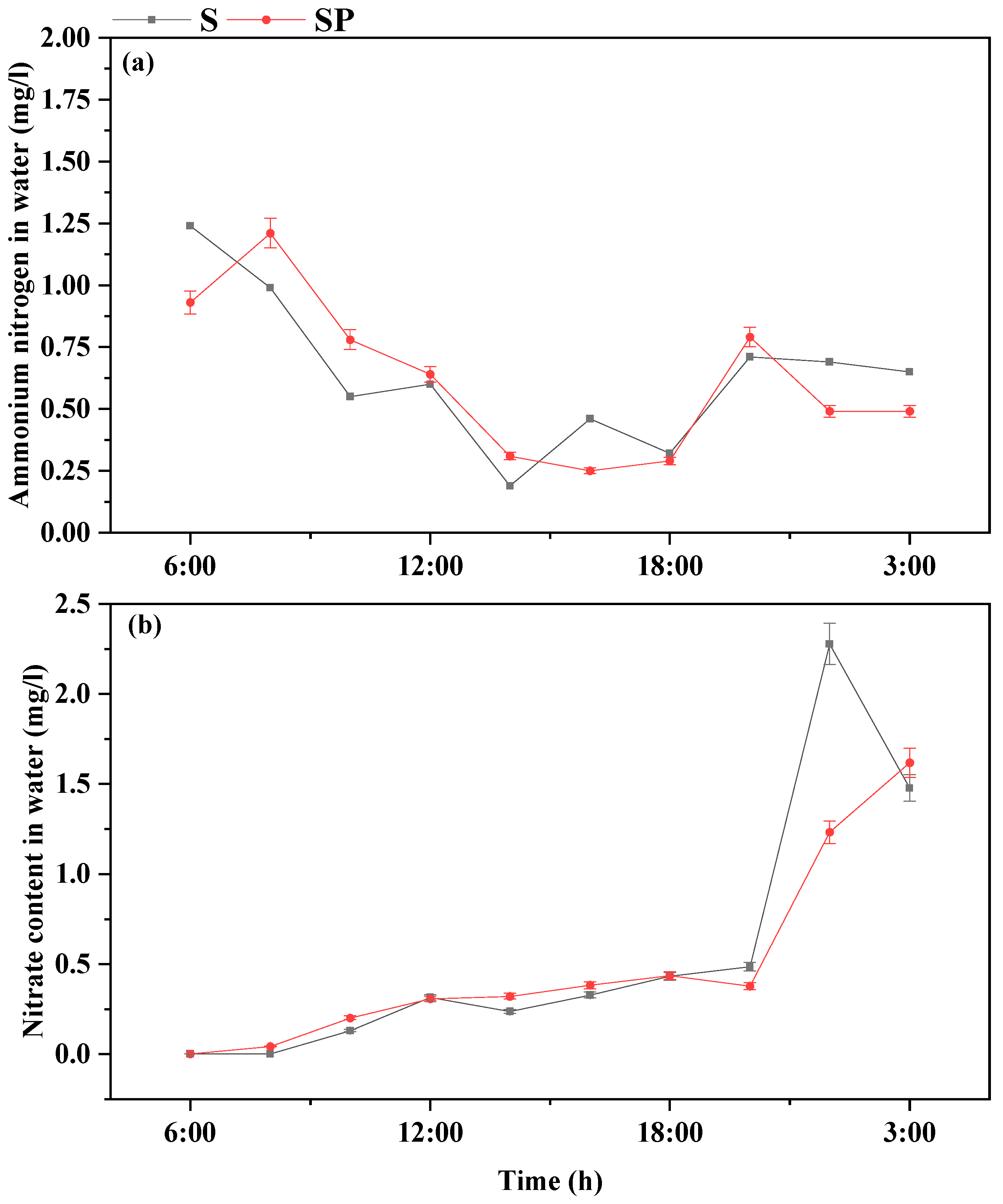
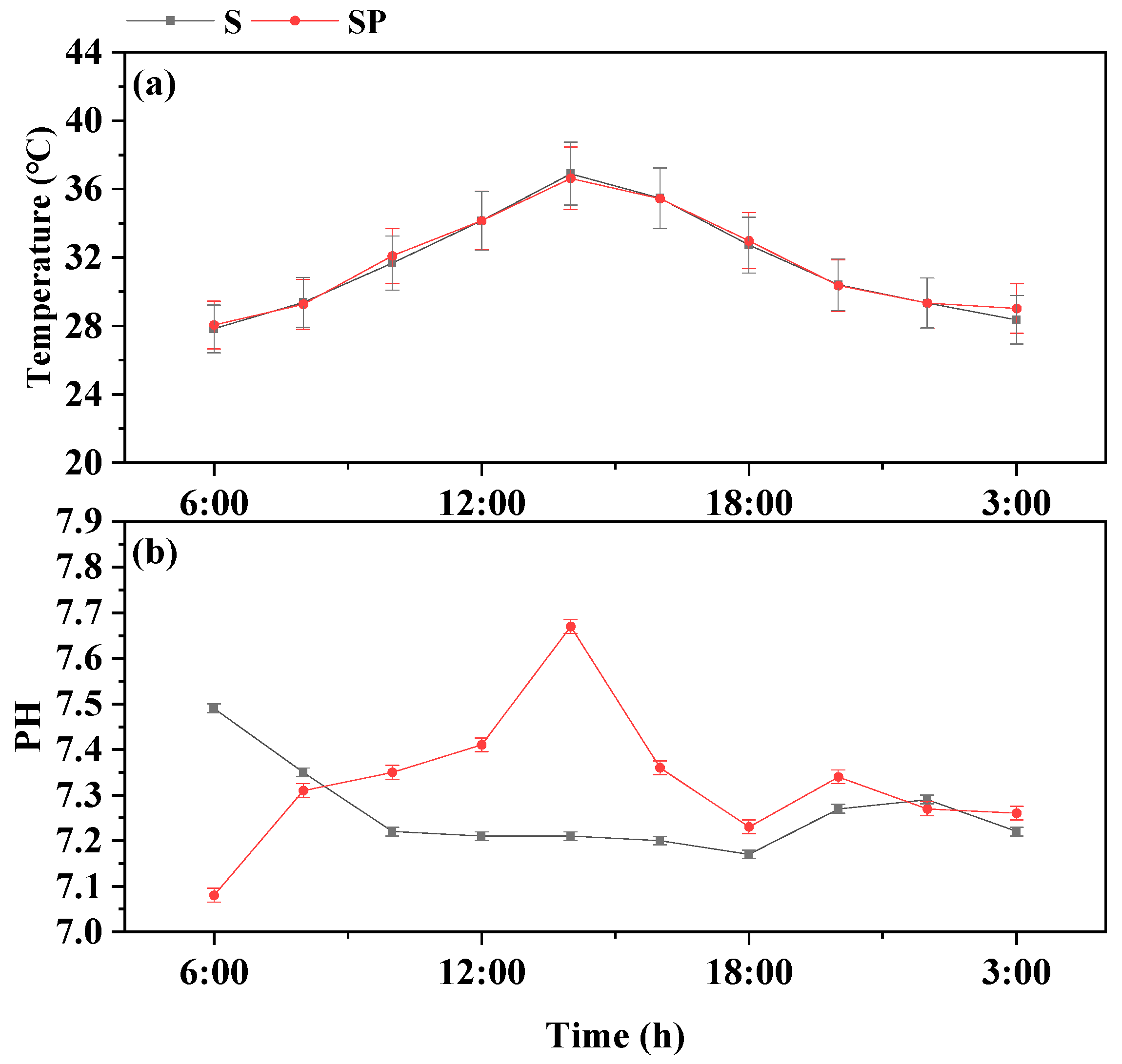

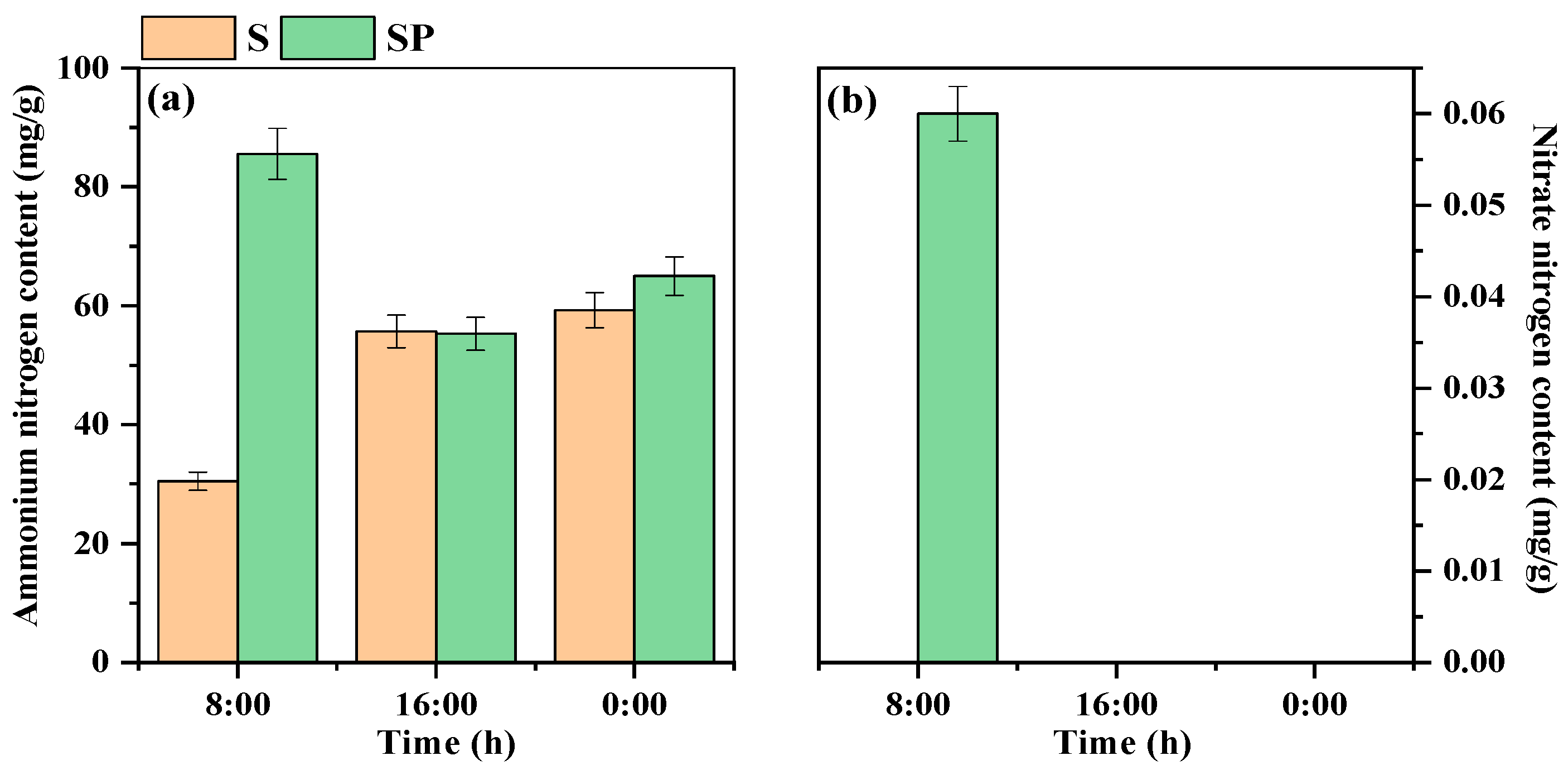

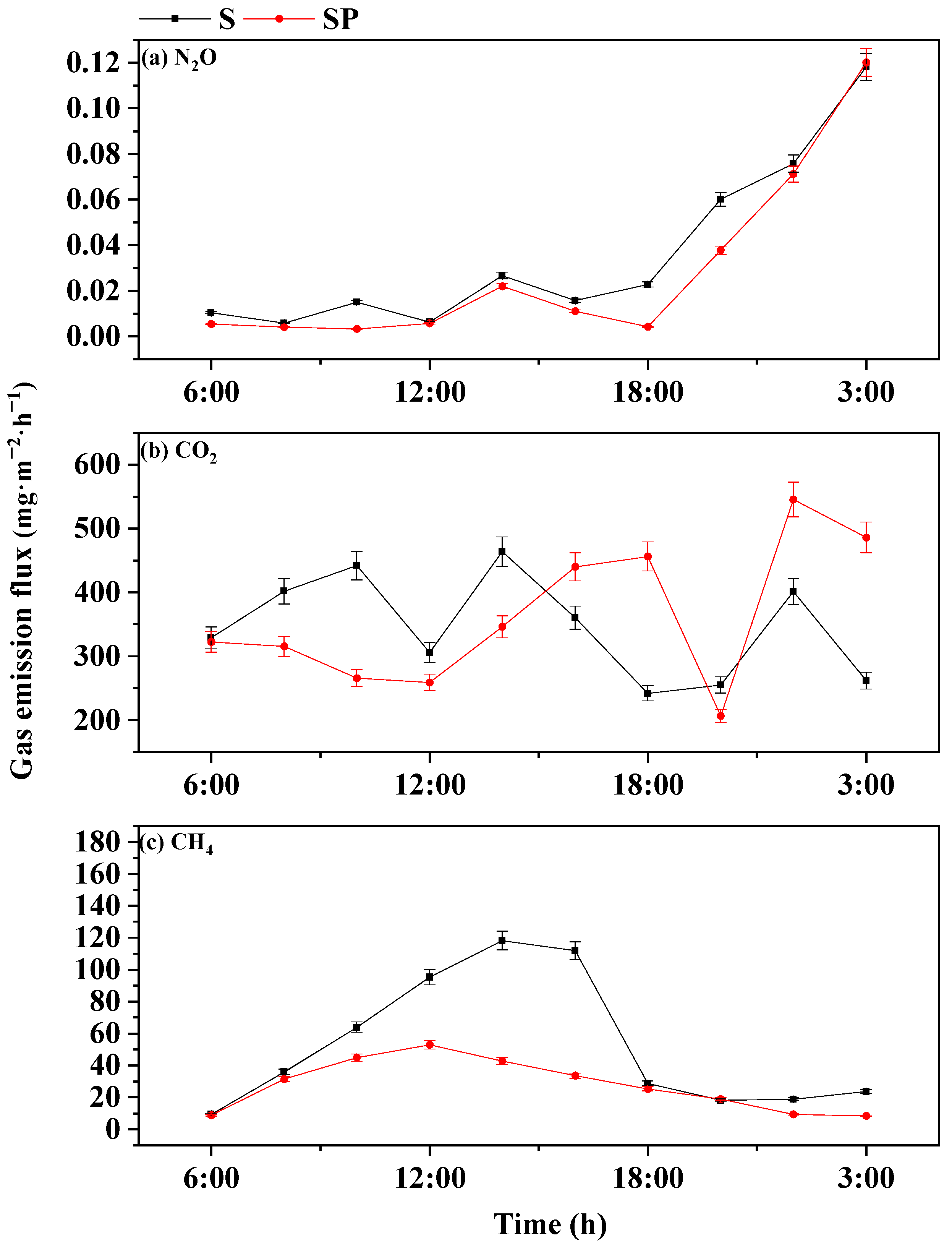

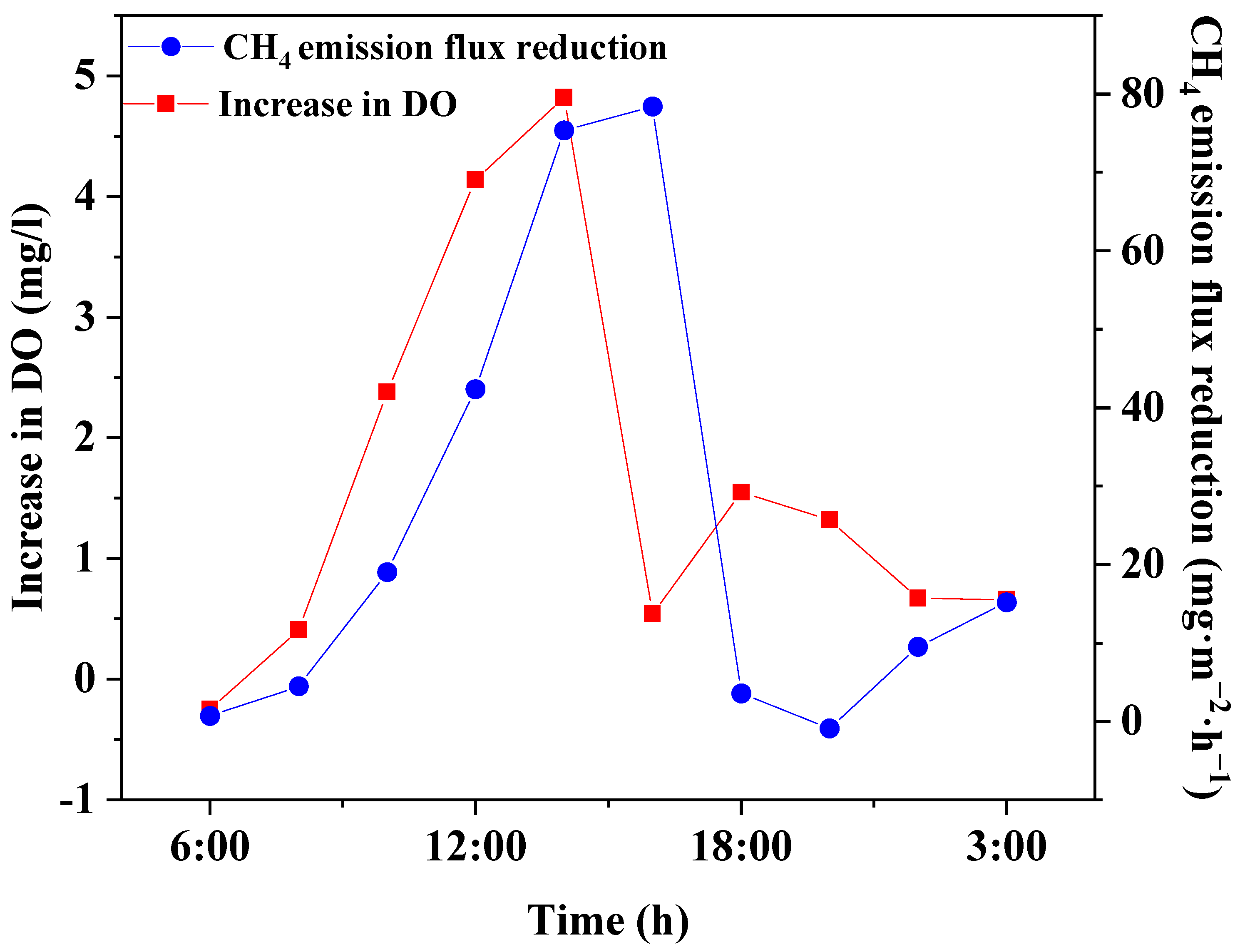
| Type of Gas | The Emission Flux (mg/m2) | GWP | The Decrease Ratio of GHG Emission Flux and Total GWP in SP Treatment Compared with S Treatment | ||
|---|---|---|---|---|---|
| S | SP | S | SP | ||
| N2O | 1.04 | 0.8 | 309.92 | 238.4 | 23.19% |
| CO2 | 8129.14 | 8914.44 | 8129.14 | 8914.44 | −9.66% |
| CH4 | 1126.65 | 605.23 | 28,166.25 | 15,130.75 | 46.28% |
| The total | 36,605.31 | 24,283.59 | 33.66% | ||
Publisher’s Note: MDPI stays neutral with regard to jurisdictional claims in published maps and institutional affiliations. |
© 2022 by the authors. Licensee MDPI, Basel, Switzerland. This article is an open access article distributed under the terms and conditions of the Creative Commons Attribution (CC BY) license (https://creativecommons.org/licenses/by/4.0/).
Share and Cite
Wu, J.; Zhang, Q.; Guo, C.; Li, Q.; Hu, Y.; Jiang, X.; Zhao, Y.; Wang, J.; Zhao, Q. Effects of Aeration on Pollution Load and Greenhouse Gas Emissions from Agricultural Drainage Ditches. Water 2022, 14, 3783. https://doi.org/10.3390/w14223783
Wu J, Zhang Q, Guo C, Li Q, Hu Y, Jiang X, Zhao Y, Wang J, Zhao Q. Effects of Aeration on Pollution Load and Greenhouse Gas Emissions from Agricultural Drainage Ditches. Water. 2022; 14(22):3783. https://doi.org/10.3390/w14223783
Chicago/Turabian StyleWu, Jingwei, Qisen Zhang, Chenyao Guo, Qiangkun Li, Yawei Hu, Xinman Jiang, Yanchao Zhao, Jing Wang, and Qiang Zhao. 2022. "Effects of Aeration on Pollution Load and Greenhouse Gas Emissions from Agricultural Drainage Ditches" Water 14, no. 22: 3783. https://doi.org/10.3390/w14223783
APA StyleWu, J., Zhang, Q., Guo, C., Li, Q., Hu, Y., Jiang, X., Zhao, Y., Wang, J., & Zhao, Q. (2022). Effects of Aeration on Pollution Load and Greenhouse Gas Emissions from Agricultural Drainage Ditches. Water, 14(22), 3783. https://doi.org/10.3390/w14223783







